Gardening is for everyone and everyone is for gardening. Don’t go searching for this as a quote on the internet; it’s our very own making. Mother nature was all a garden first with sprawling green fields, wriggling canals of water, birds, and insects humming on multi-colored flowers and trees, and a revitalizing scent engulfing the whole planet.
These fields were the means of existence for the very first human populations. They would implement their bestowed gardening tips to work up the soil, plant in the seeds of fruits and vegetables they ate, water them regularly and grow new food.
The practice of gardening is that old! While many people still use it as means of their livelihood, many have opted for it as a hobby and past time. The dimensions of gardening have evolved as well. There was no concept of home lawns then but now there is, people only learned to plant gardens from their forefathers but now every person can get complete knowledge from the internet.
This article will share all the important gardening tips that a beginner and expert, both should know of. Precisely, it would cover each of the gardening steps sequentially, the considerations for that particular process and the gardening tools required for executing that step perfectly and effectively.
Table of Contents
How to start a garden:
“Gardening adds years to your life and life to your years” – Unknown
And it all starts with the land preparation for the garden. The foundation of a plant is its roots and quite similarly, land preparation is the foundation of growing a magnificent garden.
1. Be smart in choosing the best spot for growing the garden

An ideal location for a garden should receive plenty of sunlight. Almost all flowers and vegetables need at least 6-8 hours of sunshine every day especially in the initial phases of their development. Many weeds and ferns love the shade so the lesser light your garden is receiving, the more chances are you giving to these unwanted species to grow.
Then, comes the water. Choose a location where the water supply is nearby. Or where the water hose can reach easily. You wouldn’t want to invest in a long water pipe to reach your field because it would not be just expensive but you have to go through the hassle of winding and unwinding it each time.
Water is life for a plant because no water would mean no metabolism and eventual death. How often have you seen lush plants springing in the deserts? Not many, right? Plants need water for photosynthesis which is the process whereby they will make food inside them. Without this process, plants are of no use.
Also, they need water for transpiration which is the pull that transports water from the roots to each and every part of the plant including the stem, leaves, and flowers.
Water is also needed to absorb nutrients from the soil. Roots cannot directly suck in the solute particles from the soil, they need a medium in which those can dissolve to become a solution.
The garden should also be present on a plain terrain. If the land is sloping, it would require more time and money to prepare it for plantation, and there will be problems like surface run-off when watering them. It should also be in your accessible vision because you would then timely know of any emergency requirements it craves for.
2. Improve the fertility of the soil

The more fertile the soil is, the healthier and faster will your flowers, fruits and veggies grow. There are some smart tips to increase the productiveness of the soil. The first one is to get rid of the old sod. Tear the soil with the help of a rake or spade and remove the sod. Old soil would have hardened and might be hiding the nutrients deep within. Scraping 4-8 inches of it yields a fresh piece of land.
The second tip is to spread mulch on the land surrounding the plants. It should ideally be a mixture of fertile soil, twigs, mulched grass clippings, and compost. It carries many benefits: the moisture of the soil would be conserved which uplifts the health of the soil, the weed growth is reduced and the pleasing look of the land which may have distorted because of the previous step would be restored. Apply a layer of thickness 2-3 inches near the plants.
3. Plant easy-to-grow species

This is more of a gardening tip for beginners. Nature has provided different capabilities to plants. Some smell really great while others grow very easily, some are not affected by frost and cold weather while others are immensely attractive.
As beginners, you should consider the plants that are easier to grow like tomatoes, onions, basil, sunflower, and roses. They don’t require complex considerations, are not greatly sensitive and don’t crave constant look after. Start by growing these so you get the confidence to advance further in the field of gardening.
If your first plants would end up wilting and not growing any fruits, it would be disheartening and you might as well lose the trust in planting.
4. Provide heat to germinate powerful seedling

This hack is for the experts; who can grow plants form their seeds.
Provide heat to the seedling by placing a heating mat under the seed starting trays as consistent warm temperatures boost their growth rates. It is a good practice to prepare the seedling in small containers where each container receives separate consideration. Then, transplant them to your gardens and prepare speedy holes with the help of a drill planter.
5. Prune the seedling

Seems harsh? It isn’t because quite often, they tend to be leggy and scrawny which enhances their probability of falling over. Don’t hesitate to prune them because this will eventually result in the lateral branching instead of growing taller which makes it stronger and resistant to harsh weather.
6. Prevent the seedling from diseases

Excess moisture and poor air circulation promote them. You can easily counter the latter by installing a portable fan near the seed starting trays. As for the problem of moisture, you should know how often to water new plants.
Generally, new plants should have their roots and piece of ground surrounding them completely immersed in water. Water them every day for the first week. You can also attach a soil moisture meter to make sure you don’t overwater the seedling. It depends on specific plants like tomatoes do just fine in readings of 5-6.
To get rid of excess moisture, you can add a mixture of half chicken grit and half sphagnum. This mixture will absorb excess water from the soil and keep it optimally dry.
Planting in the garden
You would have prepared the ground for your garden and seedling by now and it’s now time to start the actual plantations. Be it vegetables, fruit plants, flowers or medical herbs, each demands a particular caring schedule. Here are a few smart tricks for this stage of gardening.
Gardening tips for winter
Your garden is sitting all cozy in the winter but your gardening obsession won’t let you see it that way. You want to stir it up a little. Follow some of these tips.
7. Winterize the plants with mulch

Not all of your plants can survive the cold weather and frosty winds so it is essential that you water them before the first frost hits. Once the soil starts getting frozen, mulch it up to 5 inches with warm soil, dried leaves, and straws. This will insulate the soil and keep it snug.
8. Grow winter crops

Chilly weather doesn’t mean you can’t grow anything. Winter crops like kale and Swiss chard along with lettuce can be grown. Contact the local nursery to know of any other species you can plant.
9. Know about the frost dates
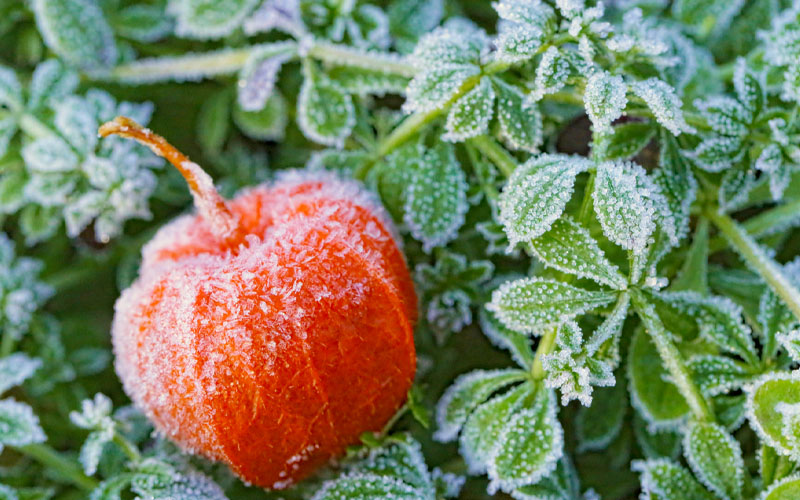
If you plant your seedling outside before the frost, there is a high probability that they will get destroyed. Learn about the frost dates and prepare your seedlings inside before that. Only after the first frost wave has passed, should you go out and plant you little plants in the soil.
10. Wrap up your plants

Cover plants in winter. Invest in a garden blanket, cardboard box, frost cover or commercially available plastic protective sheet to shield your garden against the cold winds, frost, and snow. Anchor old wooden pieces or metallic bars on the ends of the beds and secure the ends of the sheet with them.
Gardening tips for fall
Autumn or the fall season is the short time period between winters and summers. The winds become chilly and the air begins to lose its moisture. It’s usually the time you put the garden to bed and prepare it for the spring season’s bloom. But that doesn’t mean doing anything.
11. Fall species you might grow:

Species of plants you can grow in this period are Kale, Pansies, cabbage, Balloon flower, or an apple tree if you live in the warmer southern climates. You have to anticipate the fact that the roots of plants grow well in the warmer soil and there is minimal danger of a pest attack in dry weather. Before the first slap of frost, make your plants resistant enough to stand against it.
12. Rejuvenate the beds:
It’s the best time to work on the sides of the garden. You should concentrate your efforts on increasing the fertility quotient of the beds. Cover the beds with 3 inches of fresh mulch so that you not only provide them with prior winter insulation but enhances the productivity of the soil too.
13. Protect the plants for the arrival of the winter
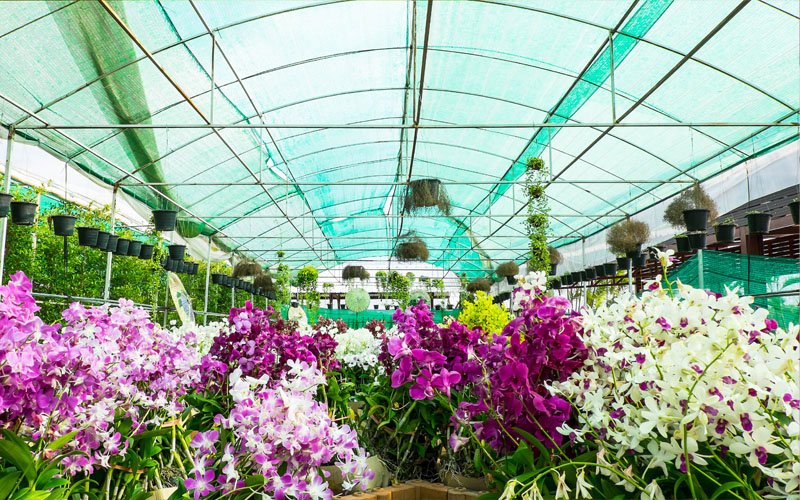
Make sure your “planted” hard work doesn’t plummet straight into the ditch of failure once the winter season arrives. To do that, use fabric shields to blanket the perennials. You can also spread the housings of a plastic sheet over the beds at nighttime.
14. Plant sprinters
Why leave the garden unattended in fall when it can give you ready-to-eat salad ingredients like arugula, spinach, and red radishes. They will spring into prepared versions within 40 days and right after the winter starts, you would have plenty of salad items to store in the fridge.
Spring gardening tips
It’s the dearest time for gardening when the planet springs into life and color. Turgid leaves start swinging jubilantly in the wind, vibrant flowers start to sway like fairies and many trees start bearing fleshy fruits.
We wouldn’t discuss the basic steps of land preparation before each season like fertilizing, adding mulch, clearing old plants e.t.c because that is a ‘given.’
15. Collect material for compost:

Survey your garden and collect everything that qualifies for becoming a part of your organic compost. It could have stuff like roots of rotten plants, branches, dried leaves, and old soil. Collect all this stuff from the beds with the help of claw garden gloves because you wouldn’t want to injure your hands by thorns or sharp stones. After that, leave a bunch of worms in the pile and wait till they do their magic.
16. Make your shovel non-stick

You will have to do plenty of digging for the spring season, and for that, you need a shovel. Right? But aren’t you fed up with mud sticking with it and needing to shake it off every time? Here’s a helping hack for you.
Spray the shovel with a Teflon or silicone lubricant which will make any soil particle slide right off it.
17. Best time to plant hardy vegetables

This is the time to grow tough vegetables like onions, tomatoes and lettuces. The tomatoes especially should be caged and staked for improving their air circulation.
18. Adorning beds
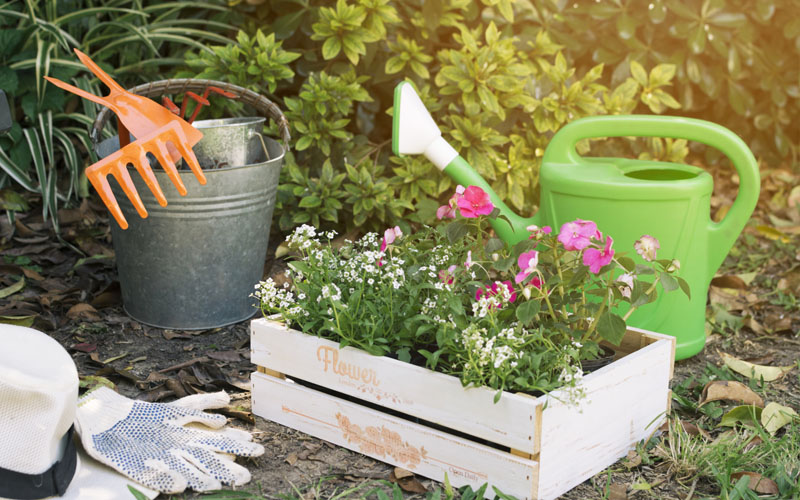
Springs is the season to decorate your garden with colorful flowers and for that, you need a dedicated bed. With the help of a rake, scrape off old debris and carpet them with healthy, organic compost you might have prepared by now.
Only after preparing the bed, should you consider adding tulip pods, daffodils, and Camelia seedlings.
19. Address the hardscaping problems
One of the important focuses should be on the hardscaping as spring winds start to blow. This is the time to repair raised stoned platforms, clean the gutters, mend the garden benches, fences and decks, and even out the stoned pathways.
One of the DIY methods to construct a new pathway leading to your garden is by using the Path Maker Mold. This metallic frame maps out an attractive pattern of cement or red mud with space in between which can be filled with granite or grass.
Spring is your gardening season like Sale season for shopping outlets. Make use of it to the fullest.
Gardening tips for summer
20. Never water at night

The plants have faced heat throughout the day and that warmth would combine with the night moisture to promote fungal growth which is a plague for your garden. Don’t water at night no matter how convenient it is.
21. Use bamboos to provide shade

While some plants like lavender and purple coneflower love remaining in direct sunlight, others won’t approve of it that much. You would need to provide shade to them. It can be in the shape of a group of bamboos stuck to the ground nearby the plants or a protective covering made with the help of embarked wooden pieces and a piece of fabric.
22. Favor the pollination
Invest in some local varieties of plants like asters and coreopsis that can allure insects and birds towards them to speed up the process of pollination in this season. You should contact your nursery and get your hands on annual sunflowers or zinnias, which are fast-growing options for edible beds.
23. Remain cool :p
Sweating in summer while you involve yourself in gardening chores? Escape that by having a wearable fan. It can be adjusted according to the neck size of any person and lets you complete the tasks without perspiring heavily. Cool, right?
Safety of plants
Just like a human body needs to be resistant to diseases, plants should be protected against them as well.
24. Protection against diseases
If you are bringing new plants from the nursery, make sure that they show no signs of diseases. If there are holes in leaves, any sort of wilting or yellowing, request the person to change the plant for you because otherwise, you would be carrying diseases to your garden yourself.
Buy the species that have a good history of disease withstanding. This would make your job very easy as the plants themselves will be majorly fighting against the infections. Miracle sweet tomatoes are great seeds that produce sweet tomatoes and are resistant to verticillium wilt, tobacco mosaic, and root nematodes.
25. Protection against fungus
Fungus and gardening go hand in hand. But you can solve this problem.
Crop rotation is a master hack. For the first time, be as experimental as you wish with the placement of the seedlings but after the first harvesting, practice crop rotation. This involves altering both the types of seeds and spots used for plantations previously. Planting in the same spots over and over again guarantees that fungus will disturb you all season long.
The fungus needs cool and wet temperatures to thrive. If you water the plants in the evening, there is every chance that the foliage will remain moist at night that will automatically favor the production of fungus. The best way to avoid this is to water early in the morning so that the plants can dry off before the night.
If you see black spots on your leaves or yellowing of leaves, it is a sign of fungal attack. Don’t hesitate to separate them from the plant before it spreads to other parts of the plant.
26. Protection against insects
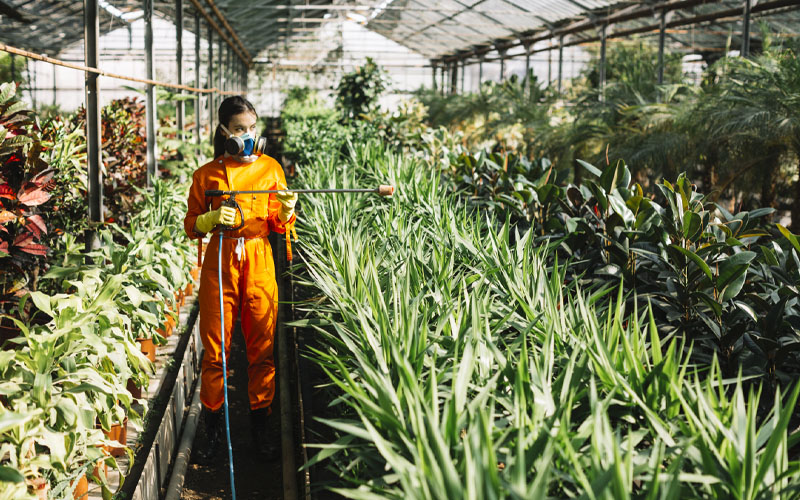
Insects or pests are another significant danger to the health of your garden. A group of pests can attack any crop at any time; there is no set pattern or condition they will follow. Pesticides are the best answer to it. Just like you would add fertilizer to the soil before a season, you need to sprinkle pesticides on plants as well. They will enhance the strength of the plants to fights against pests.
You should also consider planting pest repellant herbs on the peripherals of the garden. Carrots deter pests from tomatoes while Basil keeps away whiteflies from tomatoes.
Another gardening tip to ward off pests is to spray neem oil on the plants as it is an excellent insecticide.
27. Protection against weeds

Weeds are plant growths that deprive your plants of their fair share of nutrients by sucking them themselves.
The first trick is to mulch after regular periods. Watering sometimes takes the nutrients deep within the soil and out of the reach of the roots of plants. Low lying weeds get them and sprout out of the ground. Adding mulch deprives the weeds of light and they die eventually.
Next, take a large weeder if you have a big garden and pry up weeds like dock or dandelion with it. With a table fork or knife, pull out small weeds. If you can’t remove weeds from the roots, make sure you behead them. In this way, you would force them to use up their energy reserves and eventually exhausting their spread by limiting the production of root buds.
Fertilizing to increase productivity
You would be surprised at how naturally easy it is to improve the fertility levels of your soil after reading this section.
Everyone knows that adding fertilizers and compost are the basic fertility-enhancement steps of gardening, but we have some new stuff for you here.
28. Allow a brood of hens to eat from your garden
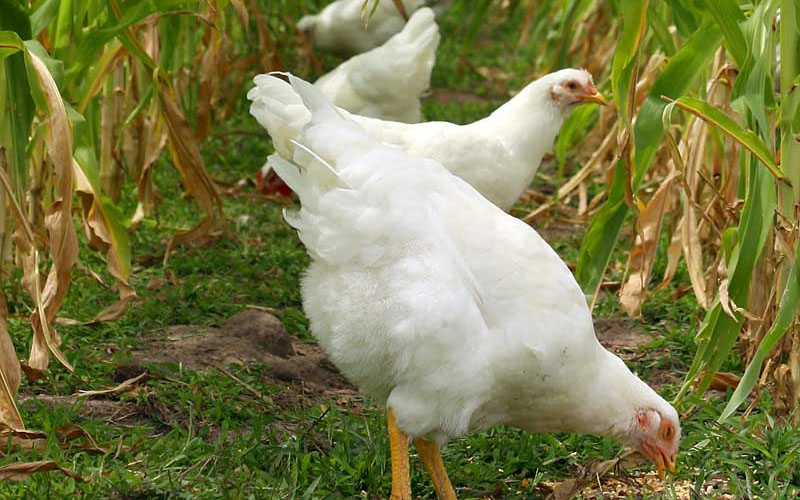
It doesn’t mean allowing them to pluck at your garden beds. It means you should spread the garden space with any organic matter you have like bread crumbs, kitchen waste and food remains. They would gnaw at it continuously and in the process, shred it onto the top of the soil. Their excretions and droppings would also prove beneficial in generating microbes that augment the fertility of the soil.
29. Plant cover crops

These crops are grown to increase the prolificacy of the soil, enhance its biodiversity and improve the soil structure. Harvested cover crops can releases nutrients like potassium, nitrogen, and manganese into the soil while the leftover roots “breathe out” oxygen that mixes with water and enters the soil. Top choices of cover crops are alfalfa, beans, and peas.
30. Mulch according to the season
Adding mulch retains the moisture and nutrients of the land and lowers the need for fertilizing. But, as gardeners, you should mulch according to the weather. In hot climates, heavier mulches are preferable because the rate of evaporation is high. In winters, however, you should consider adding lighter mulches so the soil benefits from the warmth of this mulch.
If there has been a pest attack, don’t apply too much mulch because this will shield the pests lying in or on the ground.
Conclusion
There you are. These are some of the smartest gardening tips and tricks you need to keep in mind during each stage of your gardening. We started with the considerations of planting a new garden and ended with the process of fertilizing.
Hope you enjoyed giving it a read.


